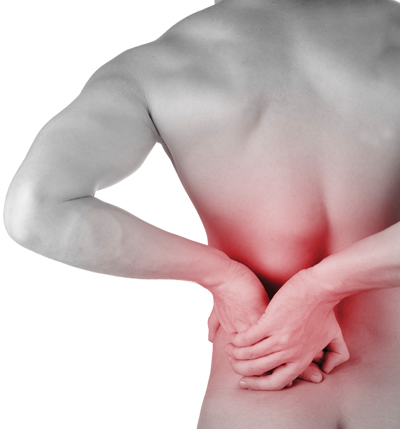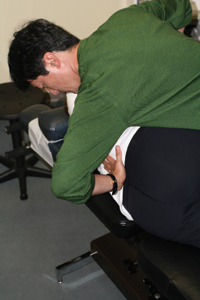
Prolotherapy, known as proliferative therapy or regenerative injection
therapy (RIT), is a non-surgical treatment, for weakened and/or damaged
ligaments, or tendons, that relieves musculoskeletal pain.
The chiropractor’s role
 |
Prolotherapy, known as proliferative therapy or regenerative injection therapy (RIT), is a non-surgical treatment, for weakened and/or damaged ligaments, or tendons, that relieves musculoskeletal pain. Typically, an irritant solution (glucose) is injected into areas where ligaments or tendons attach to the bone, triggering the body to heal the injury and thereby naturally strengthen the joint.
History of prolotherapy
Modern prolotherapy evolved from an injection technique called sclerotherapy that was first used in the 1920s to treat hernias and hemorrhoids. In the 1940s, Earl Gedney, a well-known osteopath at the Philadelphia College of Osteopathic Medicine began to use sclerotherapy for back-related ailments. It was George S. Hackett an MD from Canton, Ohio, who first coined the term “prolotherapy” in the 1950s. His book Ligament and Tendon Relaxation Treated by Prolotherapy continues to be used as a basic training reference. A newly released textbook entitled the Principles of Prolotherapy by Tom Ravin, MD, Mark Cantieri, DO, and George Pasquarello, DO, is an excellent up-to-date repository of their combined knowledge in treating acute and chronic musculoskeletal pain. Their expertise in osteopathic manipulative medicine, and painstaking collaboration has resulted in a concisely written, and visually accurate, manual.
Effects of prolotherapy
When ligaments and tendons are stretched, torn or fragmented, joints become painful. Prolotherapy has the unique ability to directly address the cause of instability and repair the weakened sites, resulting in permanent stabilization of the joint. When precisely injected into the site of pain or injury, prolotherapy stimulates the body to lay down new tendon or ligament fibres resulting in a strengthening of the weakened structure. Prolotherapy has been scientifically observed to increase the size of tendons and ligaments up to 40 per cent. It has also been shown to increase their tensile strength by as much as 200 per cent. No scar tissue is formed. The tissue formed from prolotherapy is healthy, strong, flexible ligament or tendon tissue.
 |
Indications, guidelines and patient responses
The principle of prolotherapy applies to a broad range of problems that cause musculoskeletal pain. The Florida Academy of Pain Medicine published a position paper on the “Effectiveness and Appropriate Use of Regenerative Injection Therapy” in The Pain Clinic Magazine, Vol. 4 No. 3 June 2002. Using 138 cited references, the authors state: “RIT is a safe and effective treatment modality that is very useful in a significant number of pain syndromes arising from ligament and tendon diathesis, as well as other clearly delineated pain problems. Physicians who use RIT must be knowledgeable in clinical anatomy and function, and should be properly trained in this technique via a combination of seminar/workshops, apprenticeships or visiting fellowships in order to safely and effectively utilize this treatment. The Florida Academy of Pain Medicine endorses RIT when administered appropriately for the treatment of specific chronic pain entities.”
Almost anyone can receive prolotherapy. Each person’s response to prolotherapy is different. The average number of treatments needed ranges from one to six. An injection is painful but very few patients require sedation or pain medication to undergo the treatment. As treatment progresses, the injections become less painful to receive. Mild swelling and joint stiffness may be experienced after prolotherapy injections, but these problems are temporary – some patients have been known to find relief from over-the-counter pain medications. These do not interfere with the beneficial effects of the injection(s). Heat rather than ice may also be beneficial.
The role of the chiropractor
Appropriate manual therapy augments the response to prolotherapy for several reasons. Manual skills are important in physical assessment and re-evaluation of the patient. Aberrant motor planning requires improving body awareness and learning adaptive movement strategies and proper biomechanics and posture. Functional restoration of joint mobility and muscle retraining via appropriate exercise and joint loading of the tissues being treated is paramount. This allows optimal remodeling of regenerated ligament/tendon connective tissue fibers. The success of prolotherapy is also dependent on other factors such as age, nutrition, hormonal status, vascular supply and genetics. For these reasons, a team collaborative approach, involving practitioners who can provide manual therapy, appropriate exercise and wellness advice as well as nutritional counselling, is best! Chiropractors are well positioned for all facets comprising the role of ensuring the success of prolotherapy in each patient.
For more information
Prolotherapy is a form of treatment that is approved by the American Osteopathic Association, and is endorsed by the former Surgeon General of the United States, C. Everett Koop, MD.
Other useful information can be found at: www.aaomed.org (American Association of Orthopedic Medicine); www.caom.ca (Canadian Association of Orthopedic Medicine), and www.fapmmed.net/Prolotherapy.htm (Florida Academy of Pain Management). An index of physicians who offer prolotherapy is available in the member listing areas of these sites as well as at http://getprolo.com.
In 2009, the Journal of Prolotherapy (www.journalofprolotherapy.com) will begin publication with a target audience of both health professionals and patients. The purpose of the journal will be to provide the reader with new cutting-edge information regarding prolotherapy, as well as offer a forum for providers and patients alike to tell their stories. Another excellent summary on the topic of prolotherapy and current research can be found at the personal website of Dr. K. Dean Reeves, at www.doctorreeves.com. •
Print this page